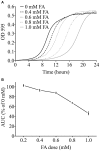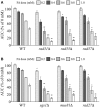Functional Toxicogenomic Profiling Expands Insight into Modulators of Formaldehyde Toxicity in Yeast
- PMID: 27909446
- PMCID: PMC5112362
- DOI: 10.3389/fgene.2016.00200
Functional Toxicogenomic Profiling Expands Insight into Modulators of Formaldehyde Toxicity in Yeast
Abstract
Formaldehyde (FA) is a commercially important chemical with numerous and diverse uses. Accordingly, occupational and environmental exposure to FA is prevalent worldwide. Various adverse effects, including nasopharyngeal, sinonasal, and lymphohematopoietic cancers, have been linked to FA exposure, prompting designation of FA as a human carcinogen by U.S. and international scientific entities. Although the mechanism(s) of FA toxicity have been well studied, additional insight is needed in regard to the genetic requirements for FA tolerance. In this study, a functional toxicogenomics approach was utilized in the model eukaryotic yeast Saccharomyces cerevisiae to identify genes and cellular processes modulating the cellular toxicity of FA. Our results demonstrate mutant strains deficient in multiple DNA repair pathways-including homologous recombination, single strand annealing, and postreplication repair-were sensitive to FA, indicating FA may cause various forms of DNA damage in yeast. The SKI complex and its associated factors, which regulate mRNA degradation by the exosome, were also required for FA tolerance, suggesting FA may have unappreciated effects on RNA stability. Furthermore, various strains involved in osmoregulation and stress response were sensitive to FA. Together, our results are generally consistent with FA-mediated damage to both DNA and RNA. Considering DNA repair and RNA degradation pathways are evolutionarily conserved from yeast to humans, mechanisms of FA toxicity identified in yeast may be relevant to human disease and genetic susceptibility.
Keywords: alternative models; formaldehyde; functional genomics; yeast.
Figures








Similar articles
-
Applying genome-wide CRISPR to identify known and novel genes and pathways that modulate formaldehyde toxicity.Chemosphere. 2021 Apr;269:128701. doi: 10.1016/j.chemosphere.2020.128701. Epub 2020 Oct 22. Chemosphere. 2021. PMID: 33189395 Free PMC article.
-
An RNAi screen in human cell lines reveals conserved DNA damage repair pathways that mitigate formaldehyde sensitivity.DNA Repair (Amst). 2018 Dec;72:1-9. doi: 10.1016/j.dnarep.2018.10.002. Epub 2018 Oct 9. DNA Repair (Amst). 2018. PMID: 30389308 Free PMC article.
-
Application of toxicogenomic profiling to evaluate effects of benzene and formaldehyde: from yeast to human.Ann N Y Acad Sci. 2014 Mar;1310(1):74-83. doi: 10.1111/nyas.12382. Epub 2014 Feb 26. Ann N Y Acad Sci. 2014. PMID: 24571325 Free PMC article. Review.
-
Identification of Genes That Modulate Susceptibility to Formaldehyde and Imatinib by Functional Genomic Screening in Human Haploid KBM7 Cells.Toxicol Sci. 2016 May;151(1):10-22. doi: 10.1093/toxsci/kfw032. Epub 2016 Mar 22. Toxicol Sci. 2016. PMID: 27008852 Free PMC article.
-
Is inhalation exposure to formaldehyde a biologically plausible cause of lymphohematopoietic malignancies?Regul Toxicol Pharmacol. 2008 Jun;51(1):119-33. doi: 10.1016/j.yrtph.2008.03.003. Epub 2008 Mar 18. Regul Toxicol Pharmacol. 2008. PMID: 18440686 Review.
Cited by
-
Applying genome-wide CRISPR to identify known and novel genes and pathways that modulate formaldehyde toxicity.Chemosphere. 2021 Apr;269:128701. doi: 10.1016/j.chemosphere.2020.128701. Epub 2020 Oct 22. Chemosphere. 2021. PMID: 33189395 Free PMC article.
-
Comparative transcriptome and metabolome analyses reveal the methanol dissimilation pathway of Pichia pastoris.BMC Genomics. 2022 May 12;23(1):366. doi: 10.1186/s12864-022-08592-8. BMC Genomics. 2022. PMID: 35549850 Free PMC article.
-
Role of Dissimilative Pathway of Komagataella phaffii (Pichia pastoris): Formaldehyde Toxicity and Energy Metabolism.Microorganisms. 2022 Jul 20;10(7):1466. doi: 10.3390/microorganisms10071466. Microorganisms. 2022. PMID: 35889185 Free PMC article.
-
The Identification of Genetic Determinants of Methanol Tolerance in Yeast Suggests Differences in Methanol and Ethanol Toxicity Mechanisms and Candidates for Improved Methanol Tolerance Engineering.J Fungi (Basel). 2021 Jan 27;7(2):90. doi: 10.3390/jof7020090. J Fungi (Basel). 2021. PMID: 33513997 Free PMC article.
-
An RNAi screen in human cell lines reveals conserved DNA damage repair pathways that mitigate formaldehyde sensitivity.DNA Repair (Amst). 2018 Dec;72:1-9. doi: 10.1016/j.dnarep.2018.10.002. Epub 2018 Oct 9. DNA Repair (Amst). 2018. PMID: 30389308 Free PMC article.
References
-
- Andersen M. E., Clewell H. J., III, Bermudez E., Dodd D. E., Willson G. A., Campbell J. L., et al. . (2010). Formaldehyde: integrating dosimetry, cytotoxicity, and genomics to understand dose-dependent transitions for an endogenous compound. Toxicol. Sci. 118, 716–731. 10.1093/toxsci/kfq303 - DOI - PubMed
LinkOut - more resources
Full Text Sources
Other Literature Sources
Molecular Biology Databases

